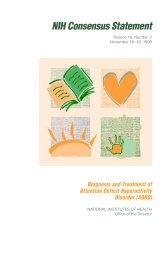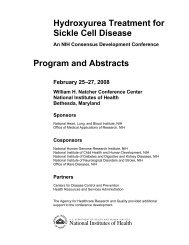patients, EATL is disseminated at diagnosis and the outlook is poor, though it may improve withchemotherapy and surgery. The 1-year survival has been estimated to be 30 percent while the5-year survival is approximately 10 percent. (5)Different studies have shown a significant association between adenocarcinoma of thesmall intestine and CD. In the largest series of this rare tumour, an associated CD was found in13 percent of cases, CD being diagnosed first in 63 percent of cases (mean lag time of 8.2 years).CD-associated adenocarcinoma was characterized by proximal (duodeno/jejunal) localizationand presentation with either acute (obstruction, haemorrhage) or chronic signs (anemia,abdominal pain, weight loss). In the majority of patients, complete surgical resection waspossible, and the overall survival at 30 months was 58 percent. (3)In a population-based cohort study from Sweden, an increased risk of oropharingeal(standardized incidence ratio = SIR of 2.3) and esophageal (SIR = 4.2) carcinomas was found inpatients with CD on long-term followup. This work also disclosed a minimal increase of the riskfor colorectal cancer (SIR = 1.5) which was owing to an increased risk for ascending andtransverse but not descending colon or rectal cancer. (6)The Magnitude of the Cancer RiskPioneer studies suggested that the CD-associated relative risk (RR) of developing NHL orother malignancies was very high, in the range of 40–100. This issue has recently beenreconsidered in the light of significant advances on CD epidemiology and diagnosis.To quantify the risk for developing NHL of any primary site associated with CD, weperformed a case control study on 653 Italian adults with NHL at the onset using the serum IgAclass antiendomysial antibody as the screening test. CD was diagnosed in only 6 of 653 patients(0.92 percent) with lymphoma. Of the six cases, three were of B-cell and three were of T-cellorigin. Four of six cases had lymphoma primarily located in the gut. The odds ratio (adjusted forage and sex) for NHL of any primary site associated with CD was 3.1 (95 percent CI 1.3–7.6),16.9 for gut lymphoma (95 percent CI 7.4–38.7), and 19.2 for T-cell lymphoma (95 percent CI7.9–46.6). (7)The Swedish cohort study found a CD-associated overall SIR of 5.9 for malignantlymphoma (95 percent CI 4.3–7.9). The excess occurrence of malignant lymphoma was confinedto adults, decreased with time of followup evaluation, and decreased over successive calendarperiods. The analysis of the causes of death in the same cohort of CD patients showed thatmortality from all malignant neoplasm combined was elevated 70 percent and was particularlyhigh for cancer of the small intestine, NHL, and liver. (6)In summary, these new studies seem to indicate that (1) CD is associated with asignificantly increased risk for NHL, especially of the T-cell type and primarily localized in thegut (EATL), and other GI cancers; (2) the CD–lymphoma association is less common thanpreviously thought, the RR being much lower than 10; and (3) the CD–cancer association ispartially responsible for the increased mortality observed in patients with CD.70
Does the Gluten-Free Diet Protect From Cancer <strong>Development</strong>?Data on the protective effect of treatment with the GFD are somewhat conflicting. On theone hand, it is evident that a large proportion of EATL and other GI cancers develop in subjectswho have been already treated for CD, sometimes for decades. (3,8) It is, however, well known thatcomplete avoidance of dietary gluten is difficult, and the possible link between the protractedingestion of gluten traces and cancer development has never been investigated. By contrast,several studies provided indirect evidence for a protective role of the GFD. In 1989, Holmesreported that the RR of overall cancer was not significantly elevated among those on a strictGFD for at least 5 years. (9) This view has found further support in studies from Finland, (10)Sweden, (6) and Italy. (11)Strict adherence to the GFD seems to be the only possibility of preventing, at leastpartially, a subset of rare but very aggressive forms of cancer.References1. Holmes GKT, Catassi C. Coeliac disease. Oxford (UK): Health Press, 2000.2. Fasano A, Catassi C. Current approaches to diagnosis and treatment of celiac disease: anevolving spectrum. Gastroenterology. 2001;120:636–651.3. Howdle PD, Jalal PK, Holmes GKT, Houlston RS. Primary small-bowel malignancy in theUK and its association with coeliac disease. Q J Med. 2003;96:345–353.4. Cellier C, Delabesse E, Helmer C, et al. Refractory sprue, celiac disease, andenteropathy-associated T-cell lymphoma. Lancet. 2000;356:203–208.5. Egan LJ, Walsh SV, Stevens FM, et al. Coeliac-associated lymphoma. A single institutionexperience of 30 cases in the combination chemotherapy era. J Clin Gastroenterol.1995;21:123–129.6. Askling J, Linet M, Grindley G, et al. Cancer incidence in a population-based cohort ofindividuals hospitalised with celiac disease or dermatitis herpetiformis. Gastroenterology.2002;123:1428–1435.7. Catassi C, Fabiani E , Corrao G, et al. Risk of non-Hodgkin lymphoma in celiac disease.JAMA. 2002;287:1413–1419.8. Green PH, Fleischauer AT, Bhagat G et al. Risk of malignancy in patients with celiacdisease. Am J Med. 2003;115:191–195.9. Holmes GKT, Prior P, Lane MR, et al. Malignancy in celiac disease. Effect of a gluten-freediet. Gut. 1989;30:333–338.10. Collin P, Reunala T, Pukkala E, et al. Coeliac disease—associated disorders and survival.Gut. 1994;35:1215–1218.71
- Page 1 and 2:
NIH Consensus Development Conferenc
- Page 3 and 4:
III. What Are the Manifestations an
- Page 5 and 6:
• What is the management of celia
- Page 7 and 8:
Monday, June 28, 2004 (continued)I.
- Page 9 and 10:
Monday, June 28, 2004 (continued)II
- Page 11 and 12: Wednesday, June 30, 2004 (continued
- Page 13 and 14: Lisa H. RichardsonConsumer Represen
- Page 15 and 16: Ciaran P. Kelly, M.D.Director, Celi
- Page 17 and 18: Van S. Hubbard, M.D., Ph.D.Director
- Page 19 and 20: AbstractsThe following are abstract
- Page 21 and 22: susceptibility (e.g., DR17 homozygo
- Page 23 and 24: The Pathology of Celiac DiseaseDavi
- Page 25 and 26: In this regard, the transport pathw
- Page 27 and 28: for the IgG-based test, while speci
- Page 29 and 30: 15. de Lecea A, Ribes-Koninckx C, P
- Page 31 and 32: Clinical Algorithm in Celiac Diseas
- Page 33 and 34: Considera diagnosisof celiac diseas
- Page 35 and 36: There are populations at particular
- Page 37 and 38: Serological Testing for Celiac Dise
- Page 39 and 40: Estimates of the sensitivity of the
- Page 41 and 42: the risk and severity of CD may als
- Page 43 and 44: What Are the Prevalence and Inciden
- Page 45 and 46: ascribed to excess menstrual loss.
- Page 47 and 48: ReferencesFamily History of Celiac
- Page 49 and 50: Carroccio A, Iannitto E, Cavataio F
- Page 51 and 52: identified by surveys or through so
- Page 53 and 54: Clinical Presentation of Celiac Dis
- Page 55 and 56: een widely reported. The question r
- Page 57 and 58: The Many Faces of Celiac Disease: C
- Page 59 and 60: References1. Green PH, Jabri B. Coe
- Page 61: Association of Celiac Disease and G
- Page 65 and 66: Skin Manifestations of Celiac Disea
- Page 67 and 68: allow a better understanding of the
- Page 69 and 70: 4. Henriksson KG, Hallert C, Walan
- Page 71 and 72: characterized, clinically-identifie
- Page 73 and 74: 10. Hoffenberg EJ, Emery LM, Barrig
- Page 75 and 76: ataxia, epilepsy with posterior cer
- Page 77 and 78: Consequences of Testing for Celiac
- Page 79 and 80: Osteoporosis/FracturesThere were 11
- Page 81 and 82: Dietary Guidelines for Celiac Disea
- Page 85 and 86: 21. Thompson T. Thiamin, riboflavin
- Page 88 and 89: In order to effectively counsel ind
- Page 90 and 91: 9. Hallert C, Granno C, Hulten S, M
- Page 92 and 93: adhered to the GFD after more than
- Page 94 and 95: Patient education, close supervisio
- Page 96: 26. Mustalahti K, Lohiniemi S, Laip







